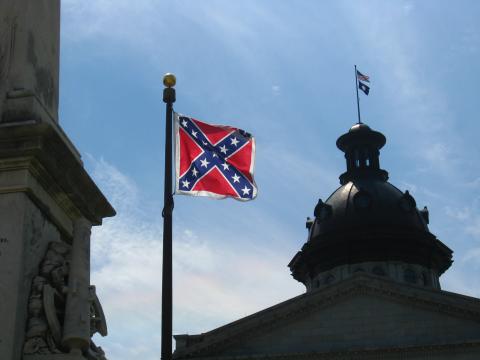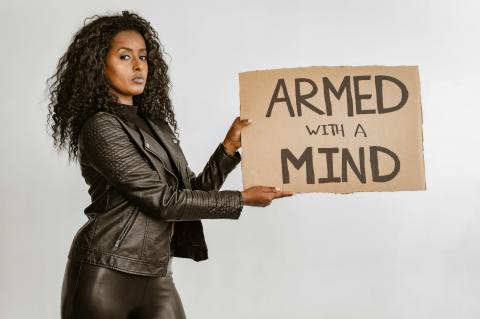Of Stars and Bars: Why Purging The Confederate Flag From American Life Accomplishes Nothing
Jul 20,2015
On July 10th, almost a month after 21-year old Dylan Roof went on a shooting spree in a historically-black Charleston church that left 9 innocent people dead, South Carolina Governor Nikki Haley oversaw the removal of the infamous battle flag flown by the Confederate Army of Northern Virginia during the Civil War from the dome of the State House in Columbia. Erroneously believed by many to have been the national flag of the Confederacy, the battle flag is seen by some as a good-natured symbol of Southern heritage and remembrance of ancestors who gave their lives during the war and by many as an odious reminder of slavery and unrepentant racism. Considering that Roof not only owned one but proudly displayed it sometime before his assault on the Charleston church, one might be more inclined to side with the later group's interpretation of the flag. Indeed , it may be true that a significant number of Southern soldiers during the war might have viewed it as a fight for independence rather than slavery, but this has no more bearing on the negative associations one might have of the flag than the fact that a significant number of German soldiers during the Second World War neither believed in nor supported National Socialism minimizes the negative associations one might have of the Iron Cross often worn by bikers and surfers today. For this reason, it is best that the divisive and yes, offensive nature of the flag be recognized and that the flag be removed from government
, it may be true that a significant number of Southern soldiers during the war might have viewed it as a fight for independence rather than slavery, but this has no more bearing on the negative associations one might have of the flag than the fact that a significant number of German soldiers during the Second World War neither believed in nor supported National Socialism minimizes the negative associations one might have of the Iron Cross often worn by bikers and surfers today. For this reason, it is best that the divisive and yes, offensive nature of the flag be recognized and that the flag be removed from government buildings like South Carolina's State House.
buildings like South Carolina's State House.
Unfortunately, as it is with all-too many political and social controversies, the story did not end there. A few weeks before the flag came down from the state capitol, Apple announced that it would remove apps that featured it from it's App Store. Although it claimed it would only go after apps that used the flag in malicious ways, Apple proceeded to remove four strategy games that used it in the "educational or historical" manner it purported to make an exception for. Around the same time, Warner Bros. announced that it would no longer produce models and replicas of The General Lee of The Dukes of Hazzard fame bearing the so-called Confederate flag on it's roof. Shortly afterwards, TV Land, apparently unable or unwilling to remove the car's flag from the program
to remove four strategy games that used it in the "educational or historical" manner it purported to make an exception for. Around the same time, Warner Bros. announced that it would no longer produce models and replicas of The General Lee of The Dukes of Hazzard fame bearing the so-called Confederate flag on it's roof. Shortly afterwards, TV Land, apparently unable or unwilling to remove the car's flag from the program itself, pulled the whole show from syndication over the matter. Not to be outdone, Ebay announced that given the flag's status as a "contemporary symbol of divisiveness and racism", they would no longer allow vendors to sell the flag and merchandise bearing it on their website. Following Ebay's example in short order were Amazon, Walmart, and Sears, with each company pulling the offending item from their shelves and webpages. This anti-Confederate flag frenzy reached some truly absurd heights, with one online commentator claiming that several teenagers complained that they carried guitars displaying the flag at the store he worked at. He posted a picture of one of the guitars in question, a limited edition Epiphone emblazoned with the Union Jack in commemoration of the 1960's British Invasion. Fortunately, it doesn't seem enough teens have complained about said guitar for Epiphone to cease production of them.
itself, pulled the whole show from syndication over the matter. Not to be outdone, Ebay announced that given the flag's status as a "contemporary symbol of divisiveness and racism", they would no longer allow vendors to sell the flag and merchandise bearing it on their website. Following Ebay's example in short order were Amazon, Walmart, and Sears, with each company pulling the offending item from their shelves and webpages. This anti-Confederate flag frenzy reached some truly absurd heights, with one online commentator claiming that several teenagers complained that they carried guitars displaying the flag at the store he worked at. He posted a picture of one of the guitars in question, a limited edition Epiphone emblazoned with the Union Jack in commemoration of the 1960's British Invasion. Fortunately, it doesn't seem enough teens have complained about said guitar for Epiphone to cease production of them.
Interestingly though, one could make the case that these teens had even more reason to complain about the Union Jack than the Stars and Bars, especially if they came from or had family from parts of the world where the "British Invasion" probably means something very different from Ed Sullivan introducing John, Paul, George and Ringo to American television audiences for the first time. Indeed, until half a century ago that flag represented an empire that not only lorded over people of color from northernmost Canada to the Indian subcontinent but also regularly bombed and gassed said people whenever they challenged or appeared to challenge their rule. Would it be at all surprising if at the very least some Africans, Native Americans, Arabs, and Indians looked upon that flag and felt emotions similar to the ones American blacks likely do when they see the Confederate flag? To return to the example of the Iron Cross referenced earlier, while Ebay purged it's site of the battle flag, it still continues to host necklaces, pendants, rings, coins, and even medals once worn by soldiers of the Wehrmacht as it rampaged across Europe. Furthermore, one can still easily buy merchandise displaying the more explicitly-offensive swastika. True, most of the items in question are antiques, but one is left to scratch their head why a similar exception wasn't made for the equally-offensive yet equally-historical Confederate flag. But it wasn't a Union Jack, an Iron Cross, or even a swastika that Dylan Roof posed in pictures with before murdering those people, it might be countered: it was the Stars and Bars! That may be so, but Roof also posed in at least one picture wearing a jacket with the flags of apartheid-era South Africa, a regime which arguably held the dubious honor of making Jim Crow look comparatively benign, and Rhodesia, a former British colony that waged a brutal, decade-long war against it's native black population after independence. Despite the fact that these flags have comparable or even stronger racist associations than the Confederate flag, they still remain available for purchase on Ebay.
I am not saying that Ebay or any other company should be forced to sell products bearing any of these symbols: as private businesses, they are free to carry or not carry whatever they please. I am also definitely not saying that they should remove merchandise bearing said symbols as they did with the Confederate flag: that is completely contrary to the point I am making. The point I am making is that the fact that Roof actively sought out clothing bearing the South African and Rhodesian flags when most Americans would just give you a confused look when you ask them to point to South Africa on a map and what Zimbabwe used to be called reveals that he was so strongly invested in white supremacist ideology that he would cling to those beliefs even if society worked to scrub anything bearing the whiff of racism in American media and merchandise away. More than likely, he would have just become more deeply involved in white supremacist sub-subculture, where this see-no-evil attitude would be cited as proof that their ideas are so alluring to white Americans that the authorities have to censor them. In the shadows, this misplaced sense of persecution would likely metastasize into even more malignant forms of hate, and by extension, more violent forms of it as well, directly leading to more Dylan Roofs and more massacres. Instead of averting ours and others' eyes from racist symbolism and driving peddlers of it into the protective shroud of the dark, we should allow them to express their bigoted beliefs as we would non-bigoted ones, where others can shine a light on the absurdity of such beliefs and expose their incoherence to members of the public. Case in point is Roof himself. During his confession, he admitted to police that he "almost didn't go through with [the shooting] because everyone was so nice to him." We all know what followed, but for a moment, the Charleston shooter doubted the morality of his murderous mission, and it wasn't because somebody confiscated his jacket with the Rhodesian flag or TV Land stopped airing The Dukes of Hazzard: it was because some of the people he irrationally hated showed him kindness and humanity, thus undermining the fundamental tenets of his racist ideology. Perhaps things would have turned out differently had Roof experienced more moments like these before that tragic day.






